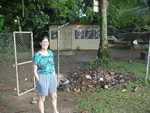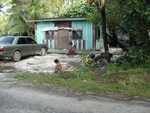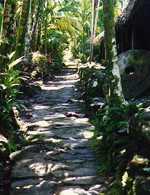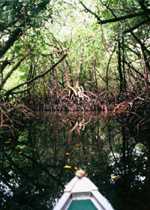| |

Just as our week in Chuuk was winding down, we experienced an unexpected change of plans. It turned out OK, though, since it allowed us time to learn about the living conditions on Chuuk, FSM flora and fauna, and what life was like for the Chuukese during Japanese occupation.
An Unexpected Twist
As with all good adventures, this one has its unexpected twists. Today our plans changed a bit. If you've been following along, you know that we were planning to have a traditional Micronesian dinner with an outer island family. However, we found out this morning that we will have to wait one more day to try breadfruit. The family cannot host us tonight, so the dinner has been switched to tomorrow.
Because our evening plans were postponed, we spent the afternoon exploring the island and getting to know some of the locals better. My mission today was to find out more about the area, since so many people have asked about it in the live chats.
Speaking of which, I want to mention how great the live chats have been. Tom and I have really enjoyed talking to all of you and we want to thank everyone for participating. One of the best things about the chats is that they help direct us on our adventure. Today we'll try to discover more about Chuukese culture, history, and living conditions -- all things you've asked about in the chats.
Living Conditions
(Click on any photo to enlarge it.)
 We have seen a wide variety of living conditions on Weno, and we have heard about even more. For instance, we learned that families on the outer islands live in houses they built themselves out of thatch from coconut palms and wood. The most incredible part about these houses is that the people who build them use rope instead of nails to hold the wood together.
We have seen a wide variety of living conditions on Weno, and we have heard about even more. For instance, we learned that families on the outer islands live in houses they built themselves out of thatch from coconut palms and wood. The most incredible part about these houses is that the people who build them use rope instead of nails to hold the wood together.
 |
 |
Here on Weno, all of the houses are made out of concrete and have metal roofs. Some houses have screens instead of windows. Many houses appear to have only one or two rooms, yet they house an entire family. We observed that, since it always hot here, the yard often becomes an extension of the house. |
Weno is the only island in the whole state of Chuuk that has 24-hour electricity. On Dublon, another quite populated island, people only get electricity for six hours everyday, from 6 p.m. (about when it gets dark) until midnight. Big diesel generators provide the electricity for these two islands. If you live on the outer islands, you can buy your own small generator, but you must haul your fuel by boat. Otherwise you survive without electricity.
 Most people that live outside of the village have a small garden. The gardens include a taro patch, breadfruit, banana, papaya and mango trees, and a few chickens. As we looked at these gardens, I wondered why we didn't see any pigs. After all, pigs eat anything, cost very little to raise, and are a good source of food. I found out that the Chuukese generally do have pigs. However, they carefully keep the pigs out of sight. Why, you ask? Well, the Chuukese have a law that says that if your pig wanders into someone else's yard, that person can keep it. Therefore, everyone is careful to keep them penned up.
Most people that live outside of the village have a small garden. The gardens include a taro patch, breadfruit, banana, papaya and mango trees, and a few chickens. As we looked at these gardens, I wondered why we didn't see any pigs. After all, pigs eat anything, cost very little to raise, and are a good source of food. I found out that the Chuukese generally do have pigs. However, they carefully keep the pigs out of sight. Why, you ask? Well, the Chuukese have a law that says that if your pig wanders into someone else's yard, that person can keep it. Therefore, everyone is careful to keep them penned up.
FSM Flora and Fauna
Pigs, like many other animals in the FSM, are not native to the area. When Europeans colonized the FSM, they brought many animals with them, such as dogs, cats, mice, rats, cattle, horses, and goats. The only land mammal native to the FSM is the bat. At one time, fruit bats were very common in the FSM, but now they are endangered because poachers and natural predators have killed off many of them.
If you think about it, it makes sense that there are few indigenous land mammals. To get to the island, the mammals would have to fly there. How else would they be able to make it across the ocean? And bats are the only mammals that fly!
Flying critters are common in the FSM. The FSM has nearly 7,000 types of insects and a wide variety of birds. Some birds include cardinal honeyeaters, white or grey Pacific reef herons, cattle egrets, kingfishers, starlings, and the endangered Micronesian megapode (we'll let you know when we figure out what that bird looks like).
The FSM also has some native reptiles, like the skink. A skink is a small lizard whose tail breaks off if you catch it (though a new one will regenerate). Some Micronesians consider the skink a "houseguest" because it lives indoors and eats household insects. Although having lizards climbing the walls of our hotel room would bug me in the U.S., it is considered normal -- even helpful -- here since they help keep down the number of mosquitoes!
In the FSM, many people fish for their food. But you'd be surprised at what can be caught on land too! Mangrove and coconut crabs often become food for Micronesians. People sometimes capture coconut crabs, though endangered, and keep them in cages until they grow larger and meatier. Coconut crabs can grow as big as 3 feet long. At this size, they are strong enough to pry open a coconut's shell, which is how they got their name.
The most important plant of Micronesia is the coconut tree. The coconut tree supplies the FSM with one of its few industries, copra production. Coconut processing plants on Chuuk take copra (the meat of the coconut) and turn it into coconut oil. Coconut oil is not only one of the island's main exports, but also a cottage industry for many of the islanders.
Micronesians make use of every part of the coconut tree. They use the sap from the flowers to make a wine called tuba; the young, green husks to make ropes; the older husks for fuel and charcoal; the tree trunks for lumber and carving; and the leaves for thatch and woven baskets. Of course, they eat the coconut meat and drink the coconut milk (believe me, an acquired taste) too.
Mangrove Swamp  Other important trees include the breadfruit tree and the mangrove tree. Breadfruit trees provide breadfruit, a staple of the Micronesian diet. We'll be telling you more about breadfruit when we report on our traditional Micronesian dinner. Mangrove trees are found in swampy areas, where their big roots loop out of the water. These roots actually help add area to the island by trapping soil between them. Little by little, the soil builds up and the trees extend further, expanding the island. This means more land for the birds, fish, and shellfish that use the trees as a home.
Other important trees include the breadfruit tree and the mangrove tree. Breadfruit trees provide breadfruit, a staple of the Micronesian diet. We'll be telling you more about breadfruit when we report on our traditional Micronesian dinner. Mangrove trees are found in swampy areas, where their big roots loop out of the water. These roots actually help add area to the island by trapping soil between them. Little by little, the soil builds up and the trees extend further, expanding the island. This means more land for the birds, fish, and shellfish that use the trees as a home.
Life in Chuuk under Japanese Occupation
I want to tell you an interesting story we heard this morning while diving. When we dive, we spend about two hours on the surface in between dives to rest. Today during our break I asked our fearless dive boat captain, Estos, what life was like for his parents. As young adults, Estos' parents lived in Chuuk during the Japanese occupation of WWII.
Estos' father lived on the island of Dublon, where many Japanese troops were based. He was 17 when Operation Hailstone hit Chuuk Lagoon. The first time Estos' father saw an American plane flying overhead, he and a bunch of friends climbed to the top of a coconut tree and waved at the plane, thinking it was harmless. When the plane came back a while later and started dropping bombs, no one thought it was funny anymore and everyone ran to hide.
Estos' father said that when the bombing started, all the Chuukese people ran uphill to some caves that had been tunneled out by the Japanese, similar to the caves we saw yesterday. As people were running to get into the cave, a bomb dropped nearby, sealing off the entrance. Sadly, many of the people who hadn't been able to get inside the cave died. Although Estos' father was still outside, he was further away and wasn't harmed. Along with some others, he ran to a different cave on the island where they all stayed for three days until the bombing stopped.
While life under Japanese rule hadn't been good for Estos' father, it got worse after Operation Hailstone. After three days in a cave, everyone was very hungry, having eaten what little food they had brought with them long before. When they finally returned to their homes, they were greeted by Japanese soldiers who had taken possession of their houses and lands.
When the Americans finished Operation Hailstone, they bypassed the islands and moved on to other battles. The 40,000 Japanese soldiers and civilians remaining after the bombings required food and shelter, so they took what they needed from the Chuukese. Japanese soldiers confiscated Chuukese houses, fields, and crops. They refused to let the Chuukese eat any of the food.
After hard times, the Chuukese were eventually evacuated. They were taken by ferry from Dublon to other islands in the lagoon, where conditions were better. In 1945, the U.S. Navy took over the Micronesian islands. In 1947, the United Nations formalized this arrangement by declaring the Micronesian islands part of a Trust Territory of the Pacific Islands. The U.S. was granted exclusive administrative rights over the Trust Territory, beginning many years of close ties to Micronesia.
Tom and I have much more to tell you about World War II and the War in the Pacific. On our way home from Chuuk, we'll be stopping in Pearl Harbor, Hawaii. We'll report back to you what we learn from our visit to the Arizona Memorial, the site of one of the most important military battles in history.
Karen
|


